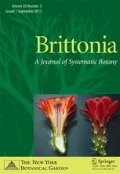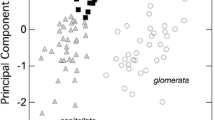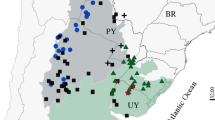Abstract
Aristolochia holostylis has long been construed as constituting a single widespread and variable species, ranging across Paraguay, Bolivia, and Brazil. However, our morphological analysis shows that populations in Bolivia, Paraguay and western Brazil differ by several constant characters of the perianth and indumentum from those in northeastern Brazil. The type specimen possesses the typical morphology of the latter populations; thus, they retain the name A. holostylis, whereas the former populations are recognized here as belonging to a new species, A. pyriflora. We provide new descriptions for both species, along with morphological comparison between them, illustration of diagnostic characters and geographic distributions, and assessment of their respective conservation statuses. The often overlooked infraspecific name Holostylis reniformis f. minor is placed in the synonymy of A. pyriflora.






Similar content being viewed by others
Literature cited
Ahumada, L. Z. 2010. Aristolochiaceae. In: L. Ramella and P. Perret (eds.), Flora del Paraguay 41: 1–74. Conservatoire et Jardin botaniques, Ville de Genève, Switzerland.
Allio, R., B. Nabholz, S. Wanke, G. Chomicki, O. A. Pérez-Escobar, A. M. Cotton, A. L. Clamens, G. J. Kergoat, F. A. H. Sperling, and F. L. Condamine. 2021. Genome-wide macroevolutionary signatures of key innovations in butterflies colonizing new host Plants. Nature Communications 12: 1–15. https://doi.org/10.1038/s41467-020-20507-3
Bachman, S., J. Moat, A. W. Hill, J. de la Torre & B. Scott. 2011. Supporting Red List threat assessments with GeoCAT: Geospatial conservation assessment tool. ZooKeys 150: 117–126. https://doi.org/10.3897/zookeys.150.2109
Blanco, M. A. 2002. Aristolochia gorgona (Aristolochiaceae), a new species with giant flowers from Costa Rica and Panama. Brittonia 54: 30–39. https://doi.org/10.1663/0007-196X(2002)054[0030:AGAANS]2.0.CO;2.
Chodat, R. & E. Hassler. 1902. Enumeration des plantes récoltées au Paraguay: Aristolochiaceae. Bulletin de l’Herbier Boissier 3(2): 167–169.
Duchartre, P. 1854. Tentamen methodicae divisionis generis Aristolochia. Annales des Sciences Naturelles 2 (4): 29–76.
Duchartre, P. 1864. Aristolochiaceae. In: A. P. de Candolle (ed.), Prodromus systematis naturalis regni vegetabilis, sive, Enumeratio contracta ordinum generum specierumque plantarum huc usque cognitarium, juxta methodi naturalis, normas digesta 15(1): 421–498. https://doi.org/10.5962/bhl.title.286
Fernández, E., I. Ferreras, B. D. Farrell, B. A. S. de Medeiros & G. A. Romero-González. 2019. Studies in Aristolochia (Aristolochiaceae) of Hispaniola. Phytotaxa 420: 1–20. https://doi.org/10.11646/phytotaxa.420.1.1.
Freitas, F., E. J. de Lírio, & F. González. 2013. A new cauliflorous species of Aristolochia (Aristolochiaceae) from Espírito Santo, Brazil. Phytotaxa 124: 55–59. https://doi.org/10.11646/phytotaxa.124.1.7.
Freitas, J., F. González & A. A. Araújo. 2019. Aristolochia lorenae, a new cauliflorous Aristolochia (Aristolochiaceae) from the Brazilian Amazonian Forest. Systematic Botany 44: 101–106. https://doi.org/10.1600/036364419X697949.
Freitas, F., E. J. de Lírio, & F. González. 2020a. Aristolochiaceae. in Flora do Brasil 2020. Jardim Botânico do Rio de Janeiro, Rio de Janeiro. http://floradobrasil.jbrj.gov.br/reflora/floradobrasil/FB15757 [Accessed: 11 Nov 2021].
Freitas, J., E. J. de Lírio, F. González, V. B. Sarnaglia Junior & A. A. Araújo. 2017a. Notes on taxonomy and nomenclature of the F. C. Hoehne’s names to Aristolochia (Aristolochiaceae). Phytotaxa 307: 65–74. https://doi.org/10.11646/phytotaxa.307.1.6.
Freitas, J., E. J. de Lírio, M. Peixoto, E. F. Guimarães & A. A. Araújo. 2017b. Aristolochia insolita (Aristolochiaceae), a new species from Rio de Janeiro, Brazil. Systematic Botany 42: 169–174. https://doi.org/10.1600/036364417X694953.
Freitas, J., F. González, O. Poncy, C. Feuillet & A. A. Araújo. 2020b. Floral geometric morphometrics unveils a new cauliflorous species of Aristolochia (Aristolochiaceae) from the Guiana Shield. Phytotaxa 474: 1–14. https://doi.org/10.11646/phytotaxa.474.1.1.
González, F. 1997. Hacia una filogenia de Aristolochia y sus congeneres neotropicales. Caldasia 19(1–2): 115–130.
González, F. 1999. Un nuevo nombre para Holostylis reniformis Duchartre (Aristolochiaceae). Revista de la Academia Colombiana de Ciencias Exactas, Físicas y Naturales 23(88): 337–339.
González, F. 2012. Florística y sistemática filogenética innecesariamente disyuntas: El caso de Aristolochia, Euglypha y Holostylis (Aristolochiaceae). Revista de La Academia Colombiana de Ciencias Exactas, Físicas y Naturales 36(139): 193–202.
González, F. & D. W. Stevenson. 2000a. Gynostemium development in Aristolochia (Aristolochiaceae). Botanische Jahrbücher für Systematik, Pflanzengeschichte und Pflanzengeographie 122: 249–291.
González, F. & D. W. Stevenson. 2000b. Perianth development and systematics of Aristolochia. Flora 195: 370–391. https://doi.org/10.1016/S0367-2530(17)30995-7.
González, F. & D. W. Stevenson. 2002. A phylogenetic analysis of the subfamily Aristolochioideae (Aristolochiaceae). Revista de La Academia Colombiana de Ciencias Exactas, Físicas y Naturales 26: 25–60.
González, F., C. Neinhuis & S. Wanke. 2005. Phylogenetic relationships of Aristolochiaceae subfamily Aristolochioideae based on molecular and morphological data. Pp. 202 in Abstracts, XVII International Botanical Congress, Vienna.
Hoehne, F. C. 1910. Aristolochiaceae. In: Commissão de linhas telegraphicas estrategicas de Matto Grosso ao Amazonas. Annexo no. 5, Historia natural. Botanica part 1: 65-69, plates 59-62. Rio de Janeiro.
Hoehne, F. C. 1927. Monographia illustrada das Aristolochiaceas brasileiras. Memórias do Instituto Oswaldo Cruz 20: 67–175.
Hoehne, F. C. 1942. Aristolochiaceae. Flora Brasílica 15: 3–141.
Huber, H. 1960. Zur Abgrenzung der Gattung Aristolochia L. Mitteilungen der Botanischen Staatssammlung München 3: 531–553.
Huber, H. 1985. Samenmerkmale und Gliederung der Aristolochiaceen. Botanische Jahrbücher Für Systematik, Pflanzengeschichte und Pflanzengeographie 107: 277–320.
Huber, H. 1993: Aristolochiaceae. In: Kubitzki, K., Rohwer, J. G. & Bittrich, V. (eds.), The Families and Genera of Vascular Plants 2: 129–137. Springer-Verlag, Berlin, Germany.
IPNI. 2021. International Plant Names Index. The Royal Botanic Gardens, Kew, Harvard University Herbaria & Libraries and Australian National Botanic Gardens. http://www.ipni.org [Accessed 20 October 2021].
IUCN. 2012. IUCN Red List Categories and Criteria, 2nd ed. IUCN, Gland, Switzerland and Cambridge, UK. http://www.ncbi.nlm.nih.gov/pubmed/2734.
IUCN. 2013. Documentation standards and consistency checks for IUCN Red List assessments and species accounts, Version 2. Adopted by the IUCN Red List Committee and IUCN SSC Steering Committee. Downloadable from: https://nc.iucnredlist.org/redlist/resources/files/1530703338-RL_Standards_Consistency.pdf.
IUCN Standards and Petitions Committee. 2019. Guidelines for using the IUCN Red List Categories and Criteria, Version 14. Downloadable from: https://nc.iucnredlist.org/redlist/content/attachment_files/RedListGuidelines.pdf.
Jiménez, J. E., R. A. Fernández & M. A. Blanco. 2021. Two new species of Aristolochia series Thyrsicae (Aristolochiaceae) from southern Central America, with comments on morphologically similar species. Phytotaxa 520: 169–183. https://doi.org/10.11646/phytotaxa.520.2.4.
Kelly, L. M. & F. González. 2003. Phylogenetic relationships in Aristolochiaceae. Systematic Botany 28: 236–49.
Kuntze, O. 1891. Aristolochiaceae. Revisio Generum Plantarum 2: 563–564. https://doi.org/10.5962/bhl.title.124064.
Martins, G. F., M. D. P. Pereira, L. M. X. Lopes, T. da Silva, P. de T. Vieira e Rosa, F. P. Barbosa, G. B. Messiano & A. U. Krettli. 2014. Intraspecific variability of Holostylis reniformis: Concentration of lignans, as determined by Maceration and Supercritical Fluid Extraction (SFE-CO2), as a function of plant provenance and plant parts. Quimica Nova 37: 281–87. https://doi.org/10.5935/0100-4042.20140048.
Murata, J., T. Ohi, S. Wu, D. Darnaedi, T. Sugawara, T. Nakanishi & H. Murata. 2001. Molecular phylogeny of Aristolochia (Aristolochiaceae) inferred from matK sequences. The Japanese Society for Plant Systematics 52:75–83.
Ohi-Toma, T., T. Sugawara, H. Murata, S. Wanke, C. Neinhuis, and J. Murata. 2006. Molecular phylogeny of Aristolochia sensu lato (Aristolochiaceae) based on sequences of rbcL, matK, and phyA genes, with special reference to differentiation of chromosome numbers. Systematic Botany 31: 481–92.
QGIS Development Team 2020. QGIS Geographic Information System, Ver. 3.22.0. Open Source Geospatial Foundation. Available from: https://qgis.org [Accessed: 20 Oct 2021].
Reichenbach, H. G. L. 1841. Das Herbarienbuch: Erklärung des natürlichen Pflanzensystems, systematische Aufzählung, Synonymik und Register der bis jetzt bekannten Pflanzengattungen. Series: Der deutsche Botaniker, 1: 77. Dresden, Leipzig, Germany. https://doi.org/10.5962/bhl.title.7694.
Pereira, M. D. P., M. R. Ferreira, G. B. Messiano, I. P. Cerávolo, L. M. X. Lopes & A. U. Krettli. 2015. Aryltetralols from Holostylis reniformis and syntheses of lignan analogous. Phytochemistry Letters 13: 200–205. https://doi.org/10.1016/j.phytol.2015.06.001.
Souza, V. C. & H. Lorenzi. 2005. Botânica Sistemática. Guia ilustrado para identificação das famílias de Angiospermas da flora brasileira, baseado em APG II. Nova Odessa, Brazil.
Wanke, S., F. González & C. Neinhuis. 2006. Systematics of pipevines: combining morphological and fast-evolving molecular characters to investigate the relationships within subfamily Aristolochioideae (Aristolochiaceae). International Journal of Plant Sciences 167: 1215–1227. https://doi.org/10.1086/508024.
WCSP. 2021. World Checklist of Selected Plant Families. Facilitated by the Royal Botanic Gardens, Kew. Published on the Internet: http://wcsp.science.kew.org/ [Accessed: 20 October 2021].
Acknowledgments
The authors are grateful to the curators of the following herbaria for making the cited specimens available for study: BHCB, CEN, COL, CONN, CTES, ESA, FI, G, HEPH, HRCB, GH, IAC, IAN, IBGE, K, L, MBML, MO, NY, P, RB, S, SJRP, SPF, UFG, UFRN, US, TEX. DF thanks Clay Dove (Florida, USA), Mauro Peixoto (São Paulo, Brazil) and Philipp Gießibl (Bavaria, Germany) for discussions on the diversity of Aristolochia holostylis and for providing photos. The Bonn University Botanic Gardens, and in particular Rebecca Hilgenhof (Edinburgh Botanic Garden) and Norbert Holstein (Natural History Museum, London), are gratefully acknowledged for enabling examination of cultivated specimens. David Prehsler (University of Vienna) kindly investigated the nomina nuda A. campanaeformis and A. cucullata in W and WU. JAL thanks the National Council for Scientific and Technological Development – CNPq for a research fellowship grant (# 303450/2016-9) and research grant (# 405553/2016-1); the Instituto Plantarum for enabling the expedition that resulted in collections of the new species, and Alessandra Ike Coan for help with the investigation of trichomes. The authors also thank Stefan Wanke and an anonymous reviewer for valuable comments on the submitted manuscript.
Author information
Authors and Affiliations
Corresponding author
Ethics declarations
Conflicts of interest statement
The authors declare that they are unaware of any conflicts of interest.
Rights and permissions
About this article
Cite this article
Frank, D., Lombardi, J.A. & Monro, A.K. A morphological study of Aristolochia holostylis (Aristolochiaceae) reveals the presence of a new species. Brittonia 74, 227–238 (2022). https://doi.org/10.1007/s12228-022-09710-2
Received:
Revised:
Accepted:
Published:
Issue Date:
DOI: https://doi.org/10.1007/s12228-022-09710-2




